TimTaiLieu.vn - Tài liệu, ebook, giáo trình, đồ án, luận văn
Tổng hợp tất cả tài liệu, ebook, giáo trình Khối Ngành Kinh Tế chọn lọc và hay nhất.

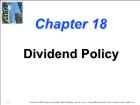 Bài giảng Financial Management - Chapter 18: Dividend Policy
Bài giảng Financial Management - Chapter 18: Dividend PolicyAfter Studying Chapter 18, you should be able to: Understand the dividend retention versus distribution dilemma faced by the firm. Explain the Modigliani and Miller (M&M) argument that dividends are irrelevant. Explain the counterarguments to M&M - that dividends do matter. Identify and discuss the factors affecting a firm's dividend and ret...
 44 trang | Chia sẻ: nguyenlinh90 | Ngày: 20/07/2019 | Lượt xem: 651 | Lượt tải: 0
44 trang | Chia sẻ: nguyenlinh90 | Ngày: 20/07/2019 | Lượt xem: 651 | Lượt tải: 0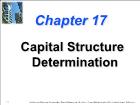 Bài giảng Financial Management - Chapter 17: Capital Structure Determination
Bài giảng Financial Management - Chapter 17: Capital Structure DeterminationAfter Studying Chapter 17, you should be able to: Define “capital structure.” Explain the net operating income (NOI) approach to capital structure and valuation of a firm; and, calculate a firm's value using this approach. Explain the traditional approach to capital structure and the valuation of a firm. Discuss the relationship between finan...
 43 trang | Chia sẻ: nguyenlinh90 | Ngày: 20/07/2019 | Lượt xem: 674 | Lượt tải: 0
43 trang | Chia sẻ: nguyenlinh90 | Ngày: 20/07/2019 | Lượt xem: 674 | Lượt tải: 0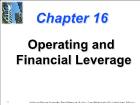 Bài giảng Financial Management - Chapter 16: Operating and Financial Leverage
Bài giảng Financial Management - Chapter 16: Operating and Financial LeverageAfter Studying Chapter 16, you should be able to: Define operating and financial leverage and identify causes of both. Calculate a firm’s operating break-even (quantity) point and break-even (sales) point . Define, calculate, and interpret a firm's degree of operating, financial, and total leverage. Understand EBIT-EPS break-even, or indiffe...
 64 trang | Chia sẻ: nguyenlinh90 | Ngày: 20/07/2019 | Lượt xem: 750 | Lượt tải: 0
64 trang | Chia sẻ: nguyenlinh90 | Ngày: 20/07/2019 | Lượt xem: 750 | Lượt tải: 0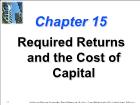 Bài giảng Financial Management - Chapter 15: Required Returns and the Cost of Capital
Bài giảng Financial Management - Chapter 15: Required Returns and the Cost of CapitalAfter Studying Chapter 15, you should be able to: Explain how a firm creates value and identify the key sources of value creation. Define the overall “cost of capital” of the firm. Calculate the costs of the individual components of a firm’s cost of capital - cost of debt, cost of preferred stock, and cost of equity. Explain and use alternati...
 51 trang | Chia sẻ: nguyenlinh90 | Ngày: 20/07/2019 | Lượt xem: 770 | Lượt tải: 0
51 trang | Chia sẻ: nguyenlinh90 | Ngày: 20/07/2019 | Lượt xem: 770 | Lượt tải: 0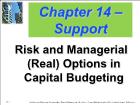 Bài giảng Financial Management - Chapter 14 – Support: Risk and Managerial (Real) Options in Capital Budgeting
Bài giảng Financial Management - Chapter 14 – Support: Risk and Managerial (Real) Options in Capital BudgetingSummary of Proposal A The standard deviation = SQRT (14,400,000) = $3,795 The expected cash flow = $5,000 Coefficient of Variation (CV) = $3,795 / $5,000 = 0.759 CV is a measure of relative risk and is the ratio of standard deviation to the mean of the distribution.
 14 trang | Chia sẻ: nguyenlinh90 | Ngày: 20/07/2019 | Lượt xem: 662 | Lượt tải: 0
14 trang | Chia sẻ: nguyenlinh90 | Ngày: 20/07/2019 | Lượt xem: 662 | Lượt tải: 0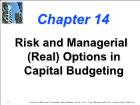 Bài giảng Financial Management - Chapter 14: Risk and Managerial (Real) Options in Capital Budgeting
Bài giảng Financial Management - Chapter 14: Risk and Managerial (Real) Options in Capital BudgetingAfter Studying Chapter 14, you should be able to: Define the "riskiness" of a capital investment project. Understand how cash-flow riskiness for a particular period is measured, including the concepts of expected value, standard deviation, and coefficient of variation. Describe methods for assessing total project risk, including a probability a...
 44 trang | Chia sẻ: nguyenlinh90 | Ngày: 20/07/2019 | Lượt xem: 644 | Lượt tải: 0
44 trang | Chia sẻ: nguyenlinh90 | Ngày: 20/07/2019 | Lượt xem: 644 | Lượt tải: 0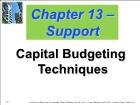 Bài giảng Financial Management - Chapter 13 – Support: Capital Budgeting Techniques
Bài giảng Financial Management - Chapter 13 – Support: Capital Budgeting TechniquesRemember? The Different Methods of Evaluation? Payback Period (PBP) Internal Rate of Return (IRR) Net Present Value (NPV) Profitability Index (PI) Let us use the ‘New Asset’ project from Chapter 12 (VW13E-13b.xlsx)
 28 trang | Chia sẻ: nguyenlinh90 | Ngày: 20/07/2019 | Lượt xem: 744 | Lượt tải: 0
28 trang | Chia sẻ: nguyenlinh90 | Ngày: 20/07/2019 | Lượt xem: 744 | Lượt tải: 0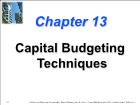 Bài giảng Financial Management - Chapter 13: Capital Budgeting Techniques
Bài giảng Financial Management - Chapter 13: Capital Budgeting TechniquesAfter Studying Chapter 13, you should be able to: Understand the payback period (PBP) method of project evaluation and selection, including its: (a) calculation; (b) acceptance criterion; (c) advantages and disadvantages; and (d) focus on liquidity rather than profitability. Understand the three major discounted cash flow (DCF) methods of project...
 65 trang | Chia sẻ: nguyenlinh90 | Ngày: 20/07/2019 | Lượt xem: 691 | Lượt tải: 0
65 trang | Chia sẻ: nguyenlinh90 | Ngày: 20/07/2019 | Lượt xem: 691 | Lượt tải: 0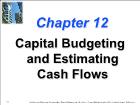 Bài giảng Financial Management - Chapter 12: Capital Budgeting and Estimating Cash Flows
Bài giảng Financial Management - Chapter 12: Capital Budgeting and Estimating Cash FlowsAfter Studying Chapter 12, you should be able to: Define capital budgeting and identify the steps involved in the capital budgeting process. Explain the procedure to generate long-term project proposals within the firm. Justify why cash, not income, flows are the most relevant to capital budgeting decisions. Summarize in a “checklist” the ma...
 34 trang | Chia sẻ: nguyenlinh90 | Ngày: 20/07/2019 | Lượt xem: 752 | Lượt tải: 0
34 trang | Chia sẻ: nguyenlinh90 | Ngày: 20/07/2019 | Lượt xem: 752 | Lượt tải: 0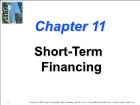 Bài giảng Financial Management - Chapter 11: Short-Term Financing
Bài giảng Financial Management - Chapter 11: Short-Term FinancingAfter Studying Chapter 11, you should be able to: Understand the sources and types of spontaneous financing. Calculate the annual cost of trade credit when trade discounts are forgone. Explain what is meant by "stretching payables" and understand its potential drawbacks. Describe various types of negotiated (or external) short-term borrowing...
 42 trang | Chia sẻ: nguyenlinh90 | Ngày: 20/07/2019 | Lượt xem: 833 | Lượt tải: 0
42 trang | Chia sẻ: nguyenlinh90 | Ngày: 20/07/2019 | Lượt xem: 833 | Lượt tải: 0
Website đang trong thời gian thử nghiệm, chờ xin giấy phép của Bộ TT & TT.

